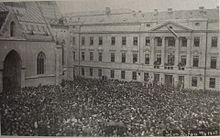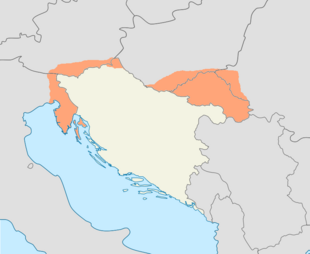State of the Slovenes, Croats and Serbs
| Država Slovenaca, Hrvata i Srba Država Slovencev, Hrvatov in Srbov |
|||||
| State of the Slovenes, Croats and Serbs | |||||
| 1918 | |||||
|
|
|||||
| Official language | Serbo-Croatian-Slovenian (de jure), Serbo-Croatian , Slovenian (de facto) | ||||
| Seat of government | Zagreb | ||||
| Head of government | Anton Korošec | ||||
| currency | SHS crown | ||||
| founding | October 29, 1918 | ||||
| Time zone | UTC +1 | ||||
| Location of the SHS state (green) in Europe | |||||
| SHS state (yellow) and its territorial claims (orange) | |||||
The State of Slovenes, Croats and Serbs ( Serbo-Croatian , Хрвата и Срба Држава Словенаца / Država Slovenaca, Hrvata i Srba , Slovenian Država Slovencev, Hrvatov in Srbov ), colloquially SHS State called, was a de facto state in Central and Southeastern Europe , which existed from October 29 to December 1, 1918 on the territory of the former Austro-Hungarian Monarchy .
history
On October 5th and 6th the National Council of Slovenes, Croats and Serbs was constituted in Zagreb (Agram in German) as the political representative of the Slovenes , Croats and Serbs of the Habsburg Monarchy . The National Council was headed by the Slovenian politician Anton Korošec as president, the Croatian politician Ante Pavelić sr. (not to be confused with the same name Ustasha founder) and the Serbian politicians Svetozar Pribicevic appointed. On October 8, 1918, the National Council raised the unification of all southern Slavs of the Habsburg Monarchy in a "free and independent state" to its program.

On October 29, 1918, at its last meeting , the Croatian Sabor dissolved the legal relations with the Kingdom of Hungary and Austria and transferred the supreme executive power to the National Council. On the same day the National Council declared a State of Slovenes, Croats and Serbs to the Slovenian National Council accession of Slovenia decided on 31 October 1918th
The official language of the SHS state was "Serbo-Croato-Slovenian".
In a note dated October 31, the National Council informed the governments of the United Kingdom , France , Italy and the United States that the state of Slovenes, Croats and Serbs had been constituted in the South Slavic territories that belonged to Austria-Hungary and that the new state State intended to form a joint state with Serbia and Montenegro. The same message was sent to the Government of the Kingdom of Serbia and the Yugoslav Committee in London. The Serbian Prime Minister Nikola Pašić responded to the communication on November 8th and recognized the National Council in Zagreb as "the legal government of Serbs, Croats and Slovenes living on the territory of Austria-Hungary" and urged the governments of the United Kingdom, France and Italy and the United States to do the same.
Under strong foreign policy pressure, especially from the Kingdom of Italy , the National Council decided on November 24, 1918, to unite the SHS state with the Kingdom of Serbia and the Kingdom of Montenegro . The National Council appointed 28 members to start negotiations with the representatives of the government of the Kingdom of Serbia and Montenegro. When creating a new Yugoslav state, the delegation negotiated directly with the Serbian regent Alexander Karađorđević .
On December 1, 1918, the Kingdom of Serbs, Croats and Slovenes ("First Yugoslavia"), also known colloquially as the SHS Kingdom , was created through the merger .
Symbols

The SHS state had not established any official state symbols. Rather, the symbols of the ethnic groups were used side by side on occasions, for example the red, white and blue tricolor and the coat of arms of the " Triune Kingdom of Dalmatia, Croatia and Slavonia " (e.g. on postage stamps of the Croatian Post).
literature
- Sabrina P. Ramet : The Three Yugoslavias. State-Building and Legitimation, 1918–2004. Indiana University Press, Bloomington, Woodrow Wilson Center Press, Washington D. C. 2006, ISBN 978-0-253-34656-8 .
- Holm Sundhaussen : Experiment Yugoslavia: from the founding of the state to the collapse of the state. BI-Taschenbuchverlag, 1993, ISBN 9783411102419 .
Individual evidence
- ↑ Erwin Holzer: The emergence of the Yugoslav state . Berlin 1929, p. 37 (dissertation).
- ↑ Mario Jareb: Hrvatski nacionalni simboli [Croatian National Symbols] . Ed .: Hrvatski institut za povijest. ALFA dd, Zagreb 2010, ISBN 978-953-297-230-6 , Od Trojednice do troimenog i troplemenog naroda, p. 162-178 (Croatian).

